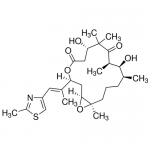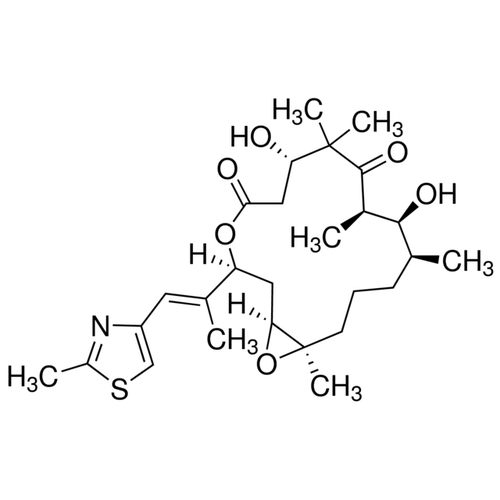| Product Name | Epothilone B |
| Description |
Microtubule stabilizer |
| Purity | >98% |
| CAS No. | 152044-54-7 |
| Molecular Formula | C27H41NO6S |
| Molecular Weight | 507.68 |
| Field of Use | Not for use in humans. Not for use in diagnostics or therapeutics. For in vitro research use only. |
Properties
| Storage Temperature | -20ºC |
| Shipping Temperature | Shipped Ambient |
| Product Type | Inducer |
| Solubility | Soluble to 10 mM in DMSO |
| Source | Synthetic |
| Appearance | White Solid |
| SMILES | C[C@H]1CCC[C@@]2([C@@H](O2)C[C@H](OC(=O)C[C@@H](C(C(=O)[C@@H]([C@H]1O)C)(C)C)O)/C(=C/C3=CSC(=N3)C)/C)C |
| InChI | InChI=1S/C27H41NO6S/c1-15-9-8-10-27(7)22(34-27)12-20(16(2)11-19-14-35-18(4)28-19)33-23(30)13-21(29)26(5,6)25(32)17(3)24(15) |
| InChIKey | QXRSDHAAWVKZLJ-PVYNADRNSA-N |
| Safety Phrases |
Classification: Caution: Substance not yet fully tested. Safety Phrases: S22 - Do not breathe dust S24/25 - Avoid contact with skin and eyes S36/37/39 - Wear suitable protective clothing, gloves and eye/face protection |
| Cite This Product | Epothilone B (StressMarq Biosciences, Canada, Cat # SIH-238) |
Biological Description
| Alternative Names | (1S,3S,7S,10R,11S,12S,16R)-7,11-Dihydroxy-8,8,10,12,16-pentamethyl-3-[(1E)-1-(2-methyl-1,3-thiazol-4-yl)-1-propen-2-yl]-4,17-dioxabicyclo[14.1.0]heptadecane-5,9-dione, Patupilone |
| Research Areas | Apoptosis, Cancer |
| PubChem ID | 448013 |
| Scientific Background | Epothilone B is a microtubule-stabilizing agent that promotes tubulin polymerization and inhibits cell division. In neuroscience, it is recognized for its neurotrophic properties, including the promotion of axonal regeneration and stabilization of microtubules in models of neurodegeneration. Epothilone B is being explored as a therapeutic candidate for diseases such as Alzheimer's, where microtubule destabilization contributes to neuronal dysfunction. |
| References |
1. Rosenberg S., Devita V.T., Hellman S. (2005) Cancer: Principles & Practice of Oncology: Lippincott Williams and Wilkins. 2. Julien B., Shah S. (2002) Antimicrob Agents Chemother. 46(9): 2772. 3. Balog D.M., et al. (1996) Angew Chem. 108: 2976. |



Reviews
There are no reviews yet.